- Spring Undergraduate Senior Thesis Poster Session
- Spring 2013, Alfred University, New York.
- The Spring senior poster session had Six senior thesis students present their work, Courtney Smith, Caelen Clark, Matthew Strohmayer, Lydia Boutelle, Nicole Keenan and Scott DeFranco Norton. Here is a brief discription of the presenters work.
- Courtney Smith - Solubility, Antibacterial Properties and Cytocompatibility of Silver Coated Glass Microspheres.
- Abstract: Amber glass particles (<90 μm) were used to synthesize glass microspheres which were then coated with silver (Ag). These silver-coated glass microspheres were compared against the uncoated analogous microspheres. The hypothesis of this experiment was that the silver-coated microspheres would eliminate bacteria in anti-bacterial testing, be non-cytotoxic and also alter the solubility of the spheres, compared to control uncoated microspheres. Both Ag coated and uncoated microspheres were characterized using X-ray diffraction (XRD), scanning electron microscopy (SEM) and energy dispersive X-ray analysis (EDS), optical microscopy, advanced surface area and porosity (ASAP). Inductively coupled plasma atomic emission spectroscopy (ICP-OES) was used to determine the solubility, while antibacterial and cell viability testing were used to determine the therapeutic effect. XRD analysis indicated no crystallinity in the initial powder stage or in the uncoated microsphere stage, but showed crystallinity of silver peaks in the silver-coated glass microspheres. SEM determined that the silver coating remained at the surface of the spheres and that there was little diffusion through the bulk. Antibacterial testing proved that the silver-coated glass microspheres inhibited the E. coli. Neither the silver-coated nor the uncoated microspheres were deemed cytotoxic and the ion release profiles indicate an increase in ion release when the glass microspheres are coated in silver.
- Caelen Clark - Characterization of Anodized Titanium Substrates for Orthopaedic Applications.
- Abstract: Titanium and its alloys are considered to be the best choice for the replacement of load-bearing hard tissue. Due to the passive oxide layer that forms on the surface of titanium it is considered to be a biocompatible material. Surface modifications are required for the promotion of the osseointegration in these materials. Anodic oxidation is a simple method of surface modification that can be used to increase the osseointegration of titanium implants. Anodic oxidation can result in the formation of a layer of TiO2 nanotubes on the metal surface. This work seeks to characterize the surface morphology and biocompatibility of anodized titanium. Atomic force microscopy, scanning electron microscopy and scanning laser profilometry were used to image the surface of anodized titanium samples. Additionally, the surface roughness of the samples was analyzed using laser profilomerty. To evaluate the biocompatibility of the samples MC3T3 osteoblast cells were seeded onto the titanium samples. The morphology and spreading of the cells was evaluated using SEM.
- Matthew Strohmayer - Preliminary Study of Polymer-Nanocomposite Synthesis, Simulated Body Fluid and Mechanical Testing.
- Abstract: Nano materials are currently being incorporated into polymer composites to improve properties such as weight, strength and bioactivity. In this study, carbon nanotubes (CNT) and Si Zr nano hydroxyapatite (nHAP) were added to Ethoxylated Bisphenol A Dimethacrylate (EBPADMA). It was found after initial synthesis of the samples that a thickening agent, fumed silica (FS), was required to prevent the pre-polymerized polymer from flowing too much. It was also found that a combination of FS and sonication promoted the nanotubes to disassociate and remain suspended in solution. Four sets of samples were synthesized, the control being just EBPADMA, the second EBPADMA and FS, the third EBPADMA FS and CNT, the final being comprised of EBPADMA FS CNT and nHAP. Then simulated body fluid (SBF) was made and five samples of disks and cylinders were immersed in 10 ml for 1, 7, and 30 days. After each time period, the mechanical strength was tested. It was found that the nano composites had a lower compressive strength between each sample and had a similar strength across the time periods, although the average strength dropped the standard deviations overlap. In biaxial flexural strength (BFS), the samples showed a reduction form the control and a slight decrease with the first two time periods and similar numbers on the final 30 day test. It was also found that after 30 day that the average BFS of the samples was higher than the control. Samples were also immersed in 60 ml of SBF and the calcium phosphate (CaP) deposition was looked at with SEM and EDS after 1, 7, and 30 days. All one day samples showed next to no CaP deposition under the SEM. The 7 day samples were seen to have some deposition, but not a significant amount. The 30 day samples had a significant 2 amount to the point where the deposition was clearly visible. The identity of this was confirmed by EDS. Based on this information, this polymer nanocomposite has potential application as bone cements.
- Spring Undergraduate Senior Thesis Poster Session
- Spring 2013, Alfred University, New York.
- Continued.
- Lydia Boutelle - Characterization of Silver Coated Bioactive Glass Particles and Glass-Polymer Hydrogel Composites.
- Abstract: Studies have shown that the addition of the silver ion (Ag+) to bioactive materials results in improved antimicrobial properties. The distribution of silver-coated bioactive glass particles throughout a two-phase hydrogel, consisting of synthesized carboxymethyl cellulose-alpha (CMC-α) and dextran-β, was studied to determine the potential for these materials to act as a sterilizing composite used for bone void filling. Surface area analysis determined that silver-coated particles had an average surface area of 0.1366 m2/g and the uncoated particles had an average surface area of 0.2149 m2/g. Elemental analysis of glass particles through Energy Dispersion Spectroscopy determined the elemental composition of each glass and images of microstructure were captured using Scanning Electron Microscopy. The inhibition zones of silver-coated glass particles in gel were compared to particles of uncoated bioactive glass in gel, and to that of control hydrogels, which contain no glass particles, swabbed with Escherichia coli. Antibacterial testing determined that Ag-coated gel composites exhibited the largest inhibition zones compared to uncoated gel composites. Broth dilution tests were conducted to observe the absorbance of each gel. A control gel, Ag-coated gel, uncoated gel, and bacteria broth were diluted with e. coli, and compared with a sterile broth. Dilution tests determined that Ag-coated gels exhibited the second-highest absorbance levels and closest to sterile broth absorbance levels. As bacterial resistance to current antibiotics increases, and the level of new antibiotics in development dwindles, studies such as these can further aid in the progression of silver use in wound healing, and antibiotic-resistant bacterial applications.
- Nicole Keenan - Characterization of Anodized Titanium Substrates for Orthopaedic Applications.
- Abstract: According to the National Cancer Institute, only 10-40% of patients who experience local recurrence of cancer within bone survive. Due to its previously determined heightened bioactivity and effectiveness against several forms of cancer, gallium has been hypothesized to be a useful component of bone void fillers by potentially decreasing the rate of bone turnover and preventing the return of cancer cells post-resection. Furthermore, hydrogels are being analyzed as the delivery mechanism for these Ga-containing bioactive glasses. Several advantages, such as a non-thermal setting reaction and the lack of harmful byproducts, are what make hydrogels an attractive candidate for this application. The goals of this study were to synthesize uniform hydrogels to act as a carrier for Ga-containing bioactive glass particles, and to examine the interactions between the hydrogels and bone tissue. These glass-hydrogel composites were assessed based upon pH, swelling ratios, rehydration tendencies, and polymer-to-water ratios, while information pertaining to their interaction with bone was assessed using scanning electron microscopy (SEM) and energy dispersive x-ray spectroscopy (EDS). It was determined that glass particles were moderately disbursed throughout the hydrogels, and that these glass-hydrogel composites effectively attach to bone. Future studies include tailoring the properties of the hydrogels and adjusting the added glass content in order to achieve optimal suspension of glass particles.
- Scott DeFranco Norton - Bioabsorbable Coronary Stents for the Reduction of Thrombosis and Restenosis.
- Abstract: Three separate magnesium based sample were compared together to conclude the ideal material to be used in coronary stenting. The samples of Mg, Mg-Zn, and Mg-Y-Zn were put through a variety of microstructural, compression and bacterial testing to compare with one another. Agglomeration of particles increased as dopants were added to the Mg and ended in the overall mechanical and antibacterial failure of Mg-Y-Zn. Mg-Zn withstood a high compression test as well as showed a homogenous sample surface after sintering process. The Mg-Zn showed good antibacterial properties when incubated with Escherichia coli. The hypothesis that adding dopants to Mg would increase the mechanical and biocompatible properties of the material was disproven; but it was positive to find that Mg-Zn had test results which comply with being an ideal material which can now be used in further analysis and testing.
- Society for Biomaterials Conference (SOB).
- April, 2013. Denver CO.
- The Society for Biomaterials Congress was held at the Colorado Convention Center in Denver, Colorado. The theme for this years meeting was "Pioneering the Future of Biomaterials". This meeting focused on promoting the development of new and novel implant materials to improve human health. The program includes the latest innovations in materials science, molecular and cell biology and engineering, new opportunities and mechanisms for translation of these findings to new or improved medical treatments. Attendees include professionals from both industry and academia to accelerate the translation of research to clinical applications. The meeting itself included Symposia, General Sessions, Workshops, Panel Discussions, and Tutorials, covering all aspects of basic, applied, and translational biomaterials science.
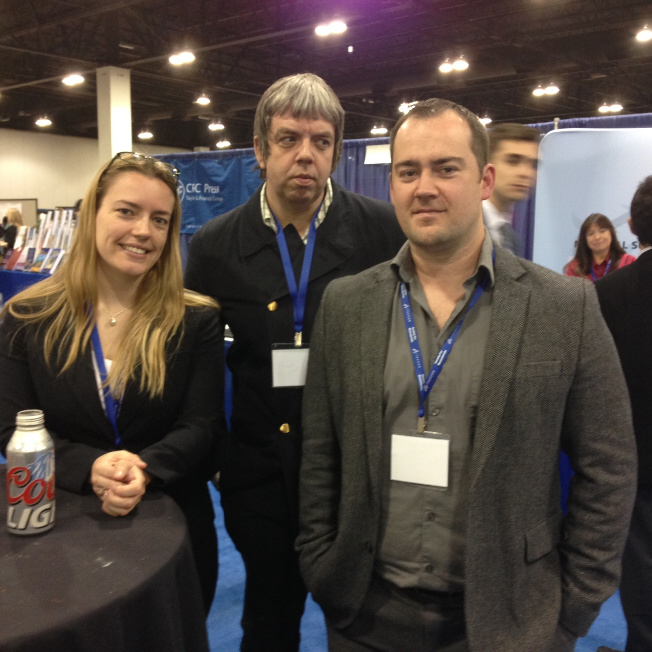
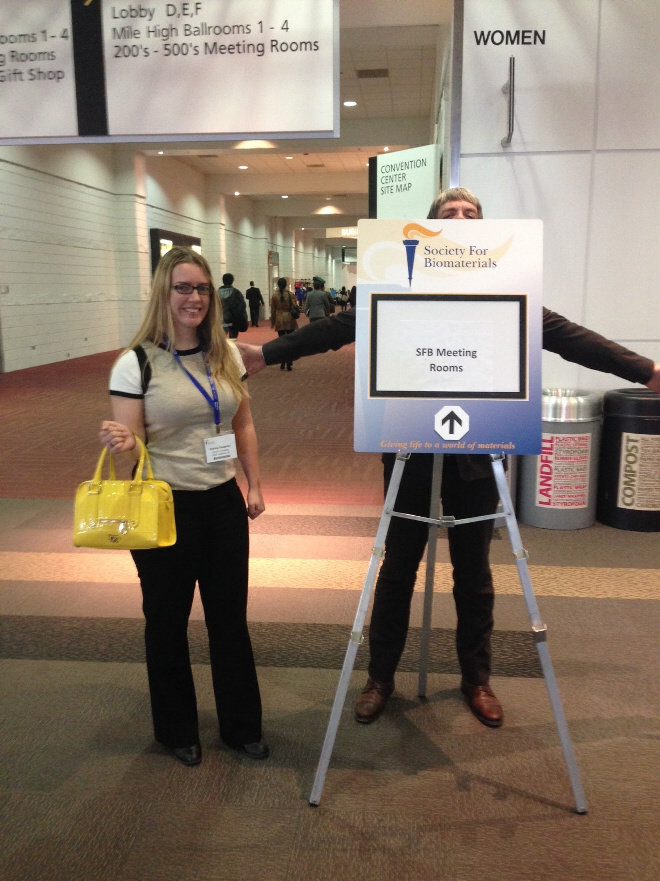
- (Left Image) From left-right Dr. Coughlan, Dr. Towler and Dr. Wren and, (Right Image) Dr. Coughlan alone, not sure where Dr. Towler is.
- See also
- Society of Biomaterials
- North Eastern Bioengineering Conference (NEBEC).
- April, 2013. Boston MA.
- The 40th annual North Eastern Bioengineering Conference (NEBEC) conference was hosted by Northeastern University's College of Engineering in Boston, Massachusetts. Excellent talks on all aspects of Bioengineering were presented by Professors from Harvard, MIT, Yale to name but a few. Sessions included topics ranging from Biomaterials, Biomedical Devices and Instrumentation and Imaging, Cell Engineering, Drug Delivery, Mechanobiology and Biomechanics, Nanomaterials and Nanotechnology, Systems and Synthetic Biology and Tissue Engineering. A reception following the conference was hosted at the Prudential Skywalk Observatory which has spectacular views of the city of Boston.

- Attendees, Dr. Anthony Wren, Ms. Lana Placek, Mr. Chokchai Yatongchai, Ms. Yiming Li and Mr Tim Keenan.
See also
North Eastern Bioengineering Conference
- Undergraduate Biomaterials Career Conference.
- October, 2013. Washington DC.
- The Southeast and Mid-Atlantic Biomedical Engineering Career Conference (SEMABECC) hosted by the University of Virginia Biomedical Engineering Department, is a one day conference designed for biomedical engineering students (undergraduate, graduate and postdoctorates) and working professionals. The conference provides a weallth of career information and networking oppertunities for participants. Students and recent graduates will learn about careers from alumni working in industry, academia, government, law and medicine. Attendees will learn about full-time oppertunities and current student can hear about intern/coop programs. Students with research projects, and design teams, can present their work during the poster session. SEMABECC also showcases the host schools BME program, students and faculty. Employers (representatives from industry and government) are invited to participate in the Career Networking Session thats included in the conference, which is hosted at the end of the day. This provides an oppertunity for employers to reach a large gathering of partiipants from wide range of schools. Universities with BME programs from throughout the region are also invited to exhibit their school to the attendees.
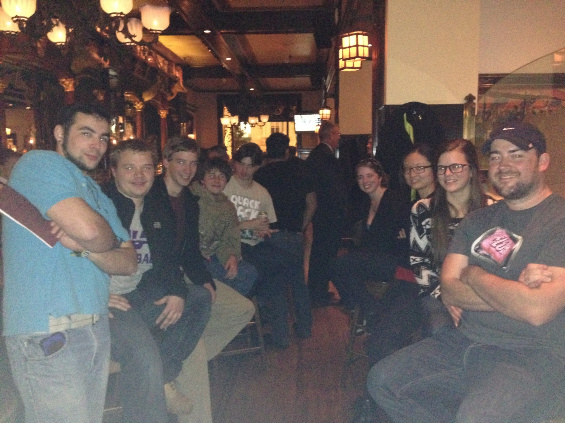
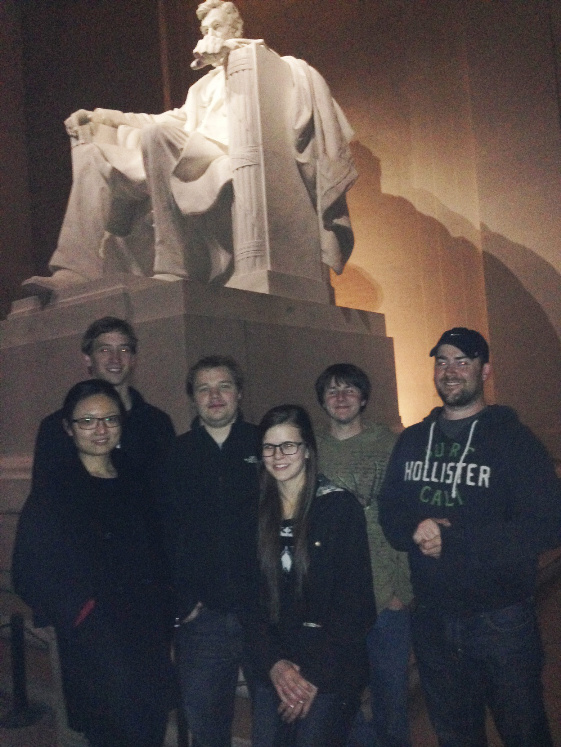

- Attendees, (right to left) Undergraduate students - Courtney Smith, Matthew Strohmeyer, Heather LIggett, Caelen Clark, Hunter Haddad, Luke Jeager, Scott Defranco-Norton, Peter saunders, Yiming Li (M.Sc) and Dr. A. Wren.
See Also
BMES Biomedical Engineering Career Conference
- North Eastern Bioengineering Conference (NEBEC).
- April, 2013. Syracuse, NY.
- The 39th Annual Northeast Bioengineering Conference was hosted by Syracuse University, Department of Biomedical and Chemical Engineering, NY, with te theme "Rehabilitative and Regenerative Engineering". In addition to the scientific programs, several career related activities were also present including a Career Fair and Expo and a Professional Development Panel designed for those early in their training and careers. Scientific sessions included talks on Molecular Cell Engineering, Biosensing, Biophotonic and Biophysics, Rehabilitative Engineering, Modeling, Bioimaging and Drug Delivery, Biomechanics and Mechanobiology in addition to an extensive poster session.



- Attendees, (right to left) Dr. A. Wren, Lana Placek, Tim Keenan, Dr. Aisling Coughlan, Yiming Li, and Chokchai Yatongchai.
North Eastern Bioengineering Coference (NEBEC)
- Invited Talk at Downstate Medical Center, Brooklyn, NY.
- Novmber, 2013
- I travelled to Downstate Medical Center in Nov 2013 to give an invited graduate seminar to both medical students and PhD students. Thank you to Professor Subrata Saha, a former Alfred University faculty member, for the invitation to come and talk in addition to establishing some new collaborators such as Dr. Saha and Dr. Janina Ferbinteanu, a research neuroscientist as Downstate. I presented a talk on how glass has to potential to be applied to numerous medical applications including bone adhesives, bioactive glasses for inhibiting tumor gowth and composite in situ setting hydogels for delivery of therapeutic bioactive glass constituents.
- Invited Talk at Ivoclar Vivandet, Buffalo, NY.
- Novmber, 2013
- A gratefull thank you to the organizers, Ivoclar Vivadent and University of Buffalo Dental School for the invitation to come and speak at the symposium. I presented a talk that discusses the transition of glass polyalkenoate bone cements from their dental origins to orthopaedics. Dr. Matt Hall and I travelled to Ivoclar where the symposium was being hosted. It was great to meet Dr. Tom Hill from Ivoclar Vivadent, and Prof Robert Baier Dean of the University of Buffalo Dental School. The audience contained inductrial professionals and students from the university of Buffalo Dental School. Thank you also to Jill Kramer for the invitation to come and talk in Nov 2013.
- Fall Undergraduate Senior Thesis Poster Session
- Fall 2013, Alfred University, New York.
- The fall senior poster session had three senior thesis students present their work, Heather Liggett, Kelly-Jo Beck and Peter Saunders. Here is a brief discription of the presenters work.
- Heather Liggett - Investigating osteoblast cell populations using cyclic voltammetry.
- Abstract: In this experiment, the metabolic activity of viable osteoblast MC3T3 cells is analyzed using cyclic voltammetry, and its results are correlated to the findings of an automated trypan blue exclusion assay to determine the feasibility of cyclic voltammetry as a novel method for cell viability analysis. It is hypothesized that an increasing population of cells will yield greater concentrations of metabolites, therefore leading to observed electrochemical behaviors that change as a function of cell population. Osteoblast cells were cultured, imaged with optical light microscopy, and seeded onto a 12-well cell culture plate in increasing concentrations that were determined using a haemocytometer. The viability of cell populations were analyzed after incubation using the trypan blue assay and cyclic voltammetry. The results of cyclic voltammetry testing determined that an inverse relationship exists between the concentration of osteoblast cell metabolites in solution and the characteristic electrochemical behaviors observed. It is concluded that in comparison with currently utilized cell viability assays, cyclic voltammetry is strictly qualitative for the purposes of this experiment, but may be further developed into a simple, quick, and cost effective quantitative method with the application of significant additional research.
- Kelly Jo-Beck - Characterization of TiO2 containing glass ceramic scaffolds.
- Abstract: Bioactive glass based scaffolds are currently being investigated for applicaations in bone tissue engineering. This study was conducted to determine the effect TiO2 will have on the structure of bioengineering scaffolds at varying concentrations. XRD was undergone to confirm the amorphous properties of the five glass-ceramic samples, while EDS was done to confirm the absence of Ti in the control sample. PSA was used to compare the particle size of each sample, as smaller particle size is optimal for sintering and fabrication of scaffolds. Images were taken using a scanning electron microscope before scaffold production to also compare particle size. A polymer foam replication technique was used to prepare porous scaffolds of varying compositions. After scaffolds were formed for the control sample and the scaffold with the highest TiO2 concentration, SEM images were taken to examine the structure and macro- and micro-porosity of the scaffolds. It was determined that the addition TiO2 to the powders improved the structure of the scaffolds by forming a more defined structure and increasing the macro- and micro-porosity of the scaffold.
- Peter Saunders - Synthesis of PLGA biodegradable microspheres with encapsulated lyzozyme.
- Abstract: Traditional drug delivery methods tend to be inefficient and cannot provide site-specific drug delivery or controlled drug concentration once subcutaneously injected. Over the years Poly(lactic-co-glycolic acid) has emerged as a polymer that can be used to provide control to variables that made drug delivery systems inefficient in the past. Due to these added benefits as well PLGA’s biocompatibility with the human body research was conducted to synthesize and perform fundamental analysis on PLGA microspheres with encapsulated lysozyme. In particular, research was performed to determine the encapsulation efficiency and drug load of technique used to synthesize microspheres along with factors that affect sphere stability. In addition to the laboratory research performed, in-depth review of peer-reviewed scientific literature was completed to obtain a better understanding of the properties of PLGA and they can be modified.
- Innovations in Biomedical Materials,
- September, 2012, Raleigh, North Carolina.
- Innovation in Biomedical Materials was hosted at the Hilton North Carolina in Raleigh, NC. Special guest presenters include Delbert Day speaking on "Radioactive glass microspheres for medical applications" and Larry Hench speaking on "Bioactive glasses: New approaches for tissue repair, regeneration and prevention".
- From Alfred University, Dr. A. Wren and Dr. N. Mellott attended the conference with Dr. Mellotts graduate student Dimple Pradhan who was presenting "Structure and Biocompatability Analysis of Sol-Gel Prepared Niobium and Titanium Oxide with Temperaturein" a session entitled Metallic Implants and Coatings. Also, a former Alfred University student, Pegah Hassanzadeh also attended and presented her MSc work entitled "Antimicrobial Properties of Silver Coated Bioactive Glass Particles for Wound Healing Applications" during a session called Uses of Bioactive Glasses in New Treatments. Dr. Wren worked on this projects with Ms. Hassanzadeh during her time at Alfred University. Ms Hassanzadeh is now a PhD student at the university of Washington. Additional attendees include a close collaborator from Dalhausie University, Dr. Daniel Boyd, an Associate Professor of Biomaterials. Members of Dr. Boyds reseach groups also attended and presented at the conference, Sharon Kehoe and Xiaofang Zhang.
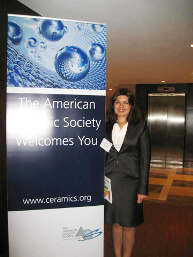

- Left, Pegah Hassanzadeh, Right Xiaofang Zhang, Prof. Larry Hench, Dimple Pradhan and Pegah Hassanzadeh.

- Left to right, Dr. N. Mellott, Dr. A. Wren Dimple Pradhan, Dr. D. Boyd, Xiaofang Zhang and Dr. S. Kehoe.